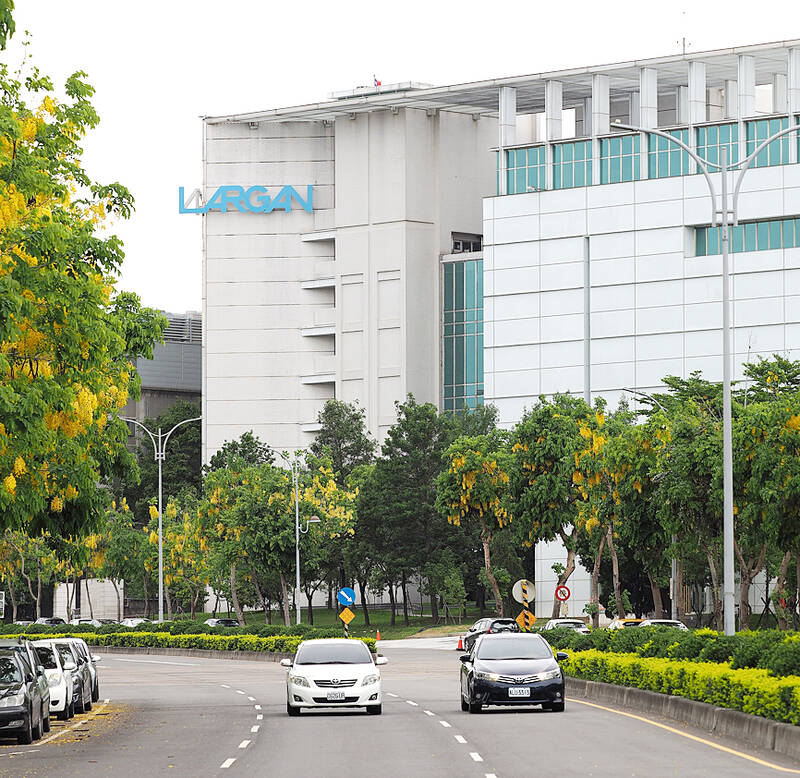Largan Precision Co (大立光), a camera lens supplier for Apple Inc’s iPhones, yesterday reported that its profit last quarter was the best in six quarters on the back of significant foreign exchange gains.
However, the Taichung-based company gave a lukewarm outlook for its first-half results, saying that smartphone vendors are slow to upgrade phone camera lenses.
Most smartphone vendors have opted for hybrid or tetraprism compact lenses for their flagship models, Largan said.

Photo: David Chang, EPA-EFE
“Not many companies are upgrading their phone specifications,” Largan chief executive officer Adam Lin (林恩平) told an online investors’ conference. “Few new phones are to hit the market in the second quarter ... although some customers are considering high-end camera lenses for mid-range phones.”
As demand is expected to stagnate, this month and next month should be “little changed” from last month, Lin said.
There was little visibility for June, he said.
Net profit last quarter soared 86 percent to NT$6.11 billion (US$189.69 million) from NT$3.29 billion a year earlier, the firm said.
On a quarterly basis, net profit expanded 23 percent from NT$4.96 billion, it said.
Earnings per share rose to NT$45.79 from NT$24.64 a year earlier and NT$37.20 a quarter earlier, it said.
Non-operating profit last quarter skyrocketed to NT$3.47 billion, with most of it from foreign exchange gains of NT$2.34 billion, compared with non-operating profit of NT$470 million a year earlier, it said.
Largan reported non-operating losses of NT$1.78 billion in the previous quarter.
Gross margin dipped to 49.2 percent last quarter due to a smaller revenue scale after a brief return to above 50 percent in the fourth quarter last year at 52.88 percent.
Last year, gross margin fell below 50 percent in the first three quarters.
Revenue last quarter grew 24 percent year-on-year to NT$11.31 billion, although it fell 37 percent sequentially.
Asked about the company’s outlook for gross margin, Lin said that “price is the most important factor, followed by utilization and yield rate.”
Gross margin for its tetraprism compact camera module, a costly camera lens adopted by premium iPhones and flagship models from other brands, should improve this quarter thanks to a better yield, he said.
Largan expects factory utilization to reach 100 percent by the end of this year, as its lenses are getting bigger, Lin said.
Largan is adding equipment as the manufacturing technology gets more complicated, he said.
The company is considering adding new capacity next year, depending on customer demand, he added.

Nvidia Corp’s demand for advanced packaging from Taiwan Semiconductor Manufacturing Co (TSMC, 台積電) remains strong though the kind of technology it needs is changing, Nvidia CEO Jensen Huang (黃仁勳) said yesterday, after he was asked whether the company was cutting orders. Nvidia’s most advanced artificial intelligence (AI) chip, Blackwell, consists of multiple chips glued together using a complex chip-on-wafer-on-substrate (CoWoS) advanced packaging technology offered by TSMC, Nvidia’s main contract chipmaker. “As we move into Blackwell, we will use largely CoWoS-L. Of course, we’re still manufacturing Hopper, and Hopper will use CowoS-S. We will also transition the CoWoS-S capacity to CoWos-L,” Huang said

Nvidia Corp CEO Jensen Huang (黃仁勳) is expected to miss the inauguration of US president-elect Donald Trump on Monday, bucking a trend among high-profile US technology leaders. Huang is visiting East Asia this week, as he typically does around the time of the Lunar New Year, a person familiar with the situation said. He has never previously attended a US presidential inauguration, said the person, who asked not to be identified, because the plans have not been announced. That makes Nvidia an exception among the most valuable technology companies, most of which are sending cofounders or CEOs to the event. That includes

TARIFF TRADE-OFF: Machinery exports to China dropped after Beijing ended its tariff reductions in June, while potential new tariffs fueled ‘front-loaded’ orders to the US The nation’s machinery exports to the US amounted to US$7.19 billion last year, surpassing the US$6.86 billion to China to become the largest export destination for the local machinery industry, the Taiwan Association of Machinery Industry (TAMI, 台灣機械公會) said in a report on Jan. 10. It came as some manufacturers brought forward or “front-loaded” US-bound shipments as required by customers ahead of potential tariffs imposed by the new US administration, the association said. During his campaign, US president-elect Donald Trump threatened tariffs of as high as 60 percent on Chinese goods and 10 percent to 20 percent on imports from other countries.

INDUSTRY LEADER: TSMC aims to continue outperforming the industry’s growth and makes 2025 another strong growth year, chairman and CEO C.C. Wei says Taiwan Semiconductor Manufacturing Co (TSMC, 台積電), a major chip supplier to Nvidia Corp and Apple Inc, yesterday said it aims to grow revenue by about 25 percent this year, driven by robust demand for artificial intelligence (AI) chips. That means TSMC would continue to outpace the foundry industry’s 10 percent annual growth this year based on the chipmaker’s estimate. The chipmaker expects revenue from AI-related chips to double this year, extending a three-fold increase last year. The growth would quicken over the next five years at a compound annual growth rate of 45 percent, fueled by strong demand for the high-performance computing